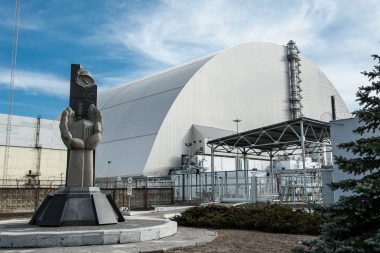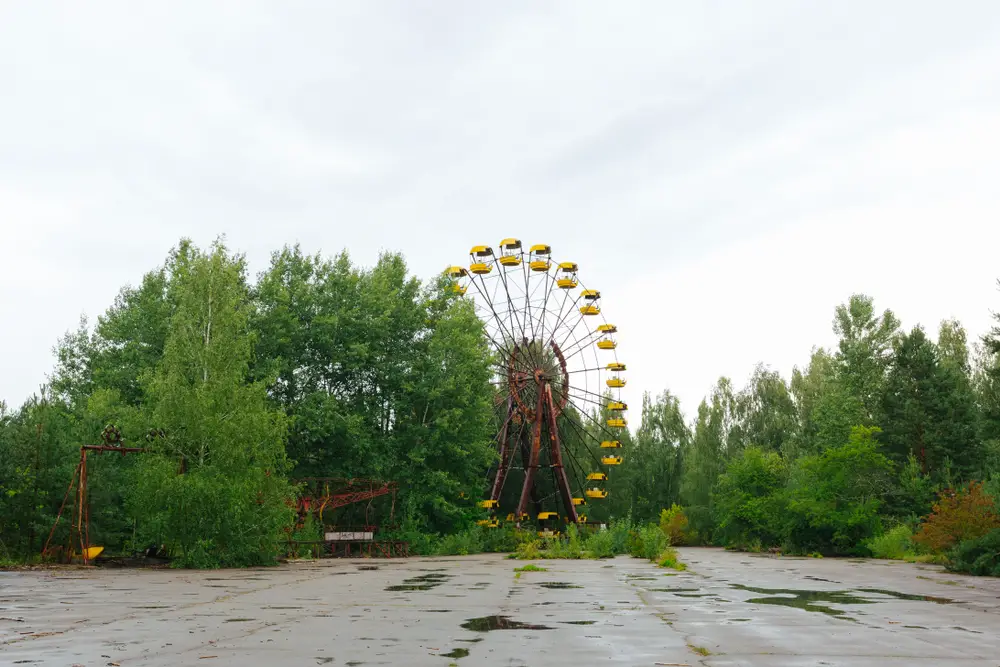On April 26, 1986, the nuclear disaster at the Chernobyl nuclear power plant in Ukraine shook the world. The disaster established an exclusion zone with a radius of 30 kilometers around the Chernobyl nuclear power plant. Today, there are many different, abandoned places in this exclusion zone. The ghost town of Pripyat is also part of the rather post-apocalyptic scenery that is now being rediscovered by tourists by booking a Chernobyl trip.
The reactor accident
At 01:23 a.m., a complete power failure was simulated in reactor block 4 of the Chernobyl nuclear power plant. The test was intended to check whether the reactor has enough energy to supply the required cooling systems until the diesel generators start up. This resulted in an uncontrolled increase in power in the nuclear reactor. As a result, the reactor block overheated and exploded. Large quantities of the radioactive material were released by the core meltdown.
The region around the nuclear power plant itself was the most contaminated with radioactive radiation in the first ten days after the disaster. Large parts of Europe and the entire northern hemisphere were also affected by the radiation. In addition to Scandinavia, Poland, the Czech Republic, Austria, southern Germany and northern Italy, the radioactive fallout also reached the Balkans, Greece and Turkey. Even today, some areas outside Ukraine are contaminated by the nuclear disaster.
After the accident, the reactor was enclosed in a sarcophagus made of steel and concrete. This is intended to reduce the further leakage of radiation. The exclusion zone was also “cleaned” in the best possible way.
Day tours to the area of the nuclear disaster
The area around the Chernobyl nuclear power plant is particularly interesting for history buffs, photographers or adventurers. Countless Lost Places have been reclaimed by nature, creating a fascinating and terrifying backdrop. Rusty beds in hospitals, fallen chairs in kindergartens and schools and a Ferris wheel whose metal struts creak in the wind – a place that is more reminiscent of a dystopia than a holiday destination.
Today, travel to the exclusion zone is still prohibited unless a specially trained guide allows an official visit. Since 2011, the government has allowed these guides to offer tours, making the historic area accessible again.
A tour usually leads through Pripyat and near the sarcophagus. Many guides offer meetings with contemporary witnesses, who offer an exclusive and individual insight into the past events. Even multi-day tours are possible.
For such an excursion, you should bring your own drinks and snacks, as there are no shops or cafés in the restricted area. The water and plants are still contaminated and therefore harmful to health. Your own Geiger counter can also be useful. Many guides offer to rent such devices.
Is it safe to travel to the exclusion zone?

The restricted area around the reactor is still radioactively contaminated. Therefore, the guides are obliged to constantly measure the radiation level with a Geiger-Müller counter. There are also further safety checks when entering and exiting the area.
On a day trip to the exclusion zone, the radiation dose absorbed is about 0.97 microsieverts per hour. The natural radiation dose in Germany , on the other hand, is about 0.23 microsieverts per hour. In the immediate vicinity of the reactor, the radiation is higher. On a long-haul flight or during X-rays, the radiation exposure is said to be even stronger than on a day trip to Pripyat. Therefore, it is now allowed to explore the exclusion zone with the help of the guided tours.
Protective clothing is not required, but for your own safety, neither plants, animals nor objects should be touched. It is even strictly forbidden to collect berries and mushrooms. The walls of the buildings must also not be touched, as there is a risk of radiation here.
For this reason, such tours are not recommended for pregnant women. Children or young people under the age of 18 are also not allowed to enter the restricted area.
Can the buildings and the reactor be visited?
In some cases, it is possible to visit the buildings. However, this only applies to selected places that the guides know. Since 2012, most of the houses in Pripyat itself have not been allowed to be entered because they are in danger of collapsing.
The reactor itself can only be visited from a distance. The area around the nuclear power plant continues to be the most radioactively contaminated, which is why a safety distance of 200 to 300 meters remains necessary. A memorial was erected at this distance, which also serves as a demarcation. Approaching closer is prohibited and should be avoided in view of one’s own health.
What does life look like today in the exclusion zone?
Despite warnings, around 700 people now live in the region around the Chernobyl nuclear power plant. Originally, about 14,000 people lived in the area, who were evacuated in the days after the Gau.
The radiation is not only harmful to humans. Animals, plants and fungi also had to adapt to the changed environmental conditions. Surprisingly, most species have managed to get used to the radioactivity quite well. For many years, scientists have therefore been researching the development of the flora and fauna around Chernobyl.
It remains to be seen how the region will develop.
Is it worth a visit?
A tour to Chernobyl is not a typical holiday trip. Nor will it be a relaxing holiday with a cocktail by the pool. But such an excursion is not only extraordinary, but impressive. Many places are reminiscent of a horror movie and warn of the consequences such accidents can have for people and nature. At the same time, plants and animals that have reclaimed the region are an image of hope that nature is finding creative ways to survive.


